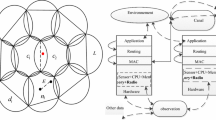Abstract
In order to make the system can obtain better throughput rate at low energy consumption under high load on the basis of limited adhere, p-detection and subsection control thought, the paper puts forward a new analysis of MAC protocol on wireless sensor network with muti-probability and joint-control random access, aiming at clustering wireless sensor networks based on event-driving and large amounts of emergent transfer data. The paper adopts average cycle analysis method to model analysis and performance index analysis, obtaining expressions of system throughput rate, average delay and communication energy consumption, etc. Performing simulation of indicators such as system throughput and communication energy consumption by MATLAB, simulation are in accord with theoretical results. MPCMA control protocol can effectively improve performance indicators of wireless sensor network based on random muti-address access under the rough load.The study lays the theoretical foundation for the application of wireless sensor network protocol combined control based on multi-probability under heavy load circumstance
















Similar content being viewed by others
References
Chenghan X, Li P et al (2017) Design of event-triggered state estimator with unknown input in wireless sensor networks. J Commun 38(21):200–206
Dianjie L et al (2018) Trusted device-to-device based heterogeneous cellular networks: a new framework for connectivity optimization. IEEE Trans Veh Technol 67(11):11219–11233
Guicai Y et al (2015) Energy efficient cooperative spectrum sensing algorithm in cognitive wireless sensor networks. J Commun 2015(3):1–11
Han X et al (2018) Ultra-thin and broadband tunable metamaterial graphene absorber, “Ultra-thin and Broadband Tunable Metamaterial Graphene Absorber”. Opt Express 26(2):1681–1688
Hongju CH et al (2018) Minimum-energy broadcast algorithm for wireless sensor networks with unreliable communications. J Softw 2015(5):1101–1112
Hongwei D et al (2010) Analysis of a new random muti-access MAC protocol and its energy efficiency for wireless sensor network. J Commun 2010(2):51–57
Hongwei T et al (2011) THO-MAC: a low-latency and energy-efficient MAC protocol with two-hop optimization in WSNs. J Natl Univer Defense Technol 2011(1):161–166
Jianping J et al (2014) QoS-MAC model of wireless sensor networks for smart distribution power grid data communication. Autom Electric Power Syst 2014(9):160–167
Jie J et al (2015) Energy-Efficient link scheduling combined with routing optimization in wireless sensor network. Acta Electronica Sinica 2015(6):1118–1124
Kumar M et al (2017) Fuzzy theoretic approach to signals and systems: static systems. Inf Sci 2017(418):668–702
Li L et al (2016) Real-time and passive wormhole detection for wireless sensor networks. J Softw 2016(27):3085–3103
Qingwen W et al (2015) An adaptive forwarding protocol for underwater wireless sensor networ. J Northwestern Polytech Univ 2015(1):165–170
Shaojun ZH et al (2019) Application technology of electrochemical sensors based on new nanomaterials. Acta Microscopica 28(3):596–601
Van DT, Langendoen K (2003) An adaptive energy-efficient MAC protocol for wireless sensor networks. In: Proc 1st Int’1 Conf. on Embedded Networked Sensor Systems (SenSys), Los Angeles, 5–7
Weiyou D et al (2017) Towards a software-defined architecture for wireless sensor networks. Chin J Comput 8(40):1779–1797
Wenping ZH et al (2017) Analytical fuzzy approach to biological data analysis. Saudi J Biol Sci 24(3):563–573
Xiaotao X et al (2018) Energy conservation strategy for wireless multimedia sensor networks based on visual correlation. J Northeastern Univ (Nat Sci 139(5):613–618
Xinchun et al (2011) Analysis of multi-access MAC protocol based on probability detection and non-persistent for wireless sensor network. Adv Mater Res 20(187):586–592
Xuan ZH et al (2014) Dynamic multichannel protocol for wireless sensor networks. J Southeast Univ (Natural Science Edition) 2014(6):1138–1142
Yasong W et al (2013) Eenergy effiency access strategy: towards hybrid wireless sensor network. J Commun 9:41–52
Ye W (2002) An energy-efficient MAC protocol for wireless sensor network. In: Proceedings of the INFOCOM 2002. San Francisco: IEEE Computer Society
Yong Y et al (2013) Energy-balanced adaptive clustering routing for indoor wireless sensor networks. J Electr Inf Technol 2013(12):2992–2998
Yongjian F et al (2014) Provacy-preserving generic approximate query in wireless sensor networks. Chin J Comput 2014(4):915–926
Zhiling R et al (2018) Review on application of WSNs. Trans Microsyst Technol 37(3):1–2
Zhou X et al (2018) Structure based user identification across social networks. IEEE Trans Knowl Data Eng 30(6):1178-119
Acknowledgment
This work is supported by Physical Electronics of Cultivating Discipline Foundation of Chuxiong Normal University (2015PYXK01). Research Application of Fusion Control Technologyof Wireless Sensor Network and Random multiple access system of Three regions Talent Support Program Project of Yunnan Province (2019YNSQ61). Modeling and Performance Analysis of Asymmetric Polling System of Scientific Research Fund Project of Department Education of Yunnan Province (2019J0401).
Author information
Authors and Affiliations
Corresponding author
Ethics declarations
Conflict of interest
The authors confirm that this article content has no conflicts of interest.
Additional information
Publisher's Note
Springer Nature remains neutral with regard to jurisdictional claims in published maps and institutional affiliations.
Rights and permissions
About this article
Cite this article
Wang, X., Cheng, M. & Liu, Y. Analysis of MAC protocol of wireless sensor network based on random multi-address access and three-probability joint-control. J Ambient Intell Human Comput 11, 3597–3606 (2020). https://doi.org/10.1007/s12652-019-01539-0
Received:
Accepted:
Published:
Issue Date:
DOI: https://doi.org/10.1007/s12652-019-01539-0




